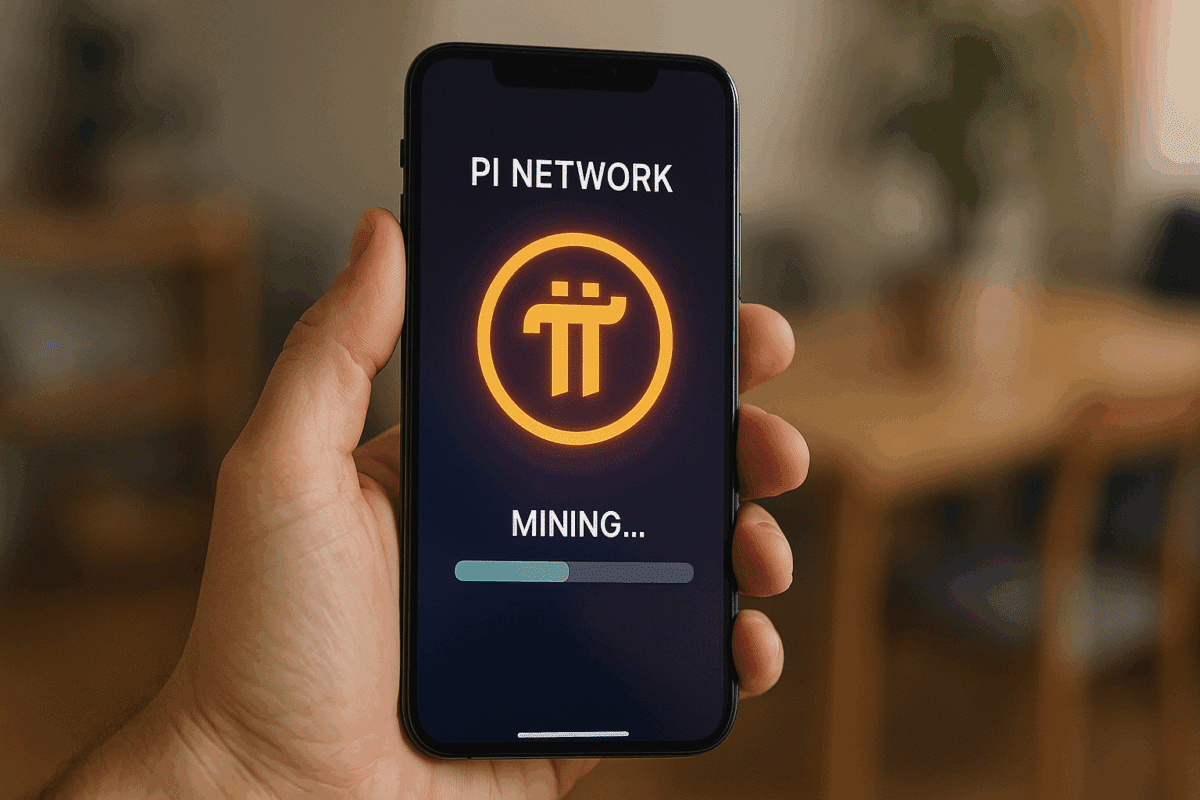
Pi Network: Mobile Mining Mystery or Real Deal?
Pi Network popped up on Pi Day, March 14, 2019, with a simple idea from some Stanford grads: make crypto easy for everyone. Forget expensive gear or needing to be a tech whiz; they said you could mine Pi coins right from your phone. Lots of people worldwide jumped on board, but plenty of others are still wondering if this whole thing will last or if Pi coins will ever be worth anything real.
What They Say They’re Doing: Crypto for the People
The folks behind Pi Network laid out their big dreams in their whitepaper. They want to: “Build a cryptocurrency and smart contracts platform secured and operated by everyday people.” And their even bigger picture? To “Build the world’s most inclusive peer-to-peer ecosystem and online experience, fueled by Pi, the world’s most widely used cryptocurrency.”
To get there, they’ve got a game plan:
- Easy for Everyone: They aim to axe the usual headaches of crypto mining, like needing supercomputers that suck up tons of power. The idea? You just tap a button on their app each day.
- Fair Share for All: The plan is to get Pi into the hands of a huge number of people across the globe, building a digital money system that’s truly open to everyone.
- No Single Boss: They’re building an ecosystem where no one person or group calls all the shots. Instead, the “Pioneers”—the users themselves—help run and mine the network.
- Real-World Use: It’s not just about collecting digital coins. A major goal is for Pi to be used for actual stuff, like buying and selling in a peer-to-peer market, or using a range of dApps for transactions, payments, DeFi, and even digital ID.
- Safe and Sound: Pi uses something called the Stellar Consensus Protocol (SCP). It also has “security circles,” where you vouch for people you trust to help keep the network secure. Plus, everyone has to do Know Your Customer (KYC) checks to make sure users are real.
- Growing a Global Tribe: Getting a massive, active, and worldwide community on board? That’s absolutely key to how they see Pi growing and getting better.
- Keeping it Simple: Making the whole thing easy to grasp and transparent is a big deal so people can use it without getting lost.
- Smart Money: They’re working on an economic setup that shares Pi fairly but also keeps it from becoming worthless by putting a 100 billion coin cap on the total supply.
From December 2021, Pi Network ran in what they called an “Enclosed Network” for its Mainnet. During this time, folks could finish their KYC and shift their mined Pi to the blockchain, but it was all kept inside the Pi world with no outside links. The big switch to an “Open Network,” which would let it connect to exchanges and everything else, finally happened on February 20, 2025.
The Brains Behind It: Stanford Roots and a Phone-First Idea
A group of Stanford University alumni cooked up Pi Network, aiming to make cryptocurrency mining something anyone could do.
Who Started It:
- Dr. Nicolas Kokkalis: He’s the Head of Technology. Dr. Kokkalis knows his stuff, with a Ph.D. in Computer Science from Stanford, where he also did Postdoctoral work and even taught Stanford’s first class on decentralized apps (CS359B). He’s worked on smart contracts, kicked off a startup accelerator called StartX, and built online social apps. For Pi Network, he’s focused on mixing distributed systems with how people use computers to make blockchain feel natural.
- Dr. Chengdiao Fan: As Head of Product, Dr. Fan has a Stanford Ph.D. in Anthropological Sciences, with a focus on human behavior and social computing. Her background is in designing software that helps people be more productive and communicate better at scale. At Pi, she’s using her social computing smarts to build an ecosystem everyone can be part of.
- Vince McPhillip (He’s Left Now): McPhillip used to be Head of Community. He’s got an M.B.A. from Stanford and a B.A. from Yale, with experience in building communities and working with non-profits. Word is McPhillip left Pi Network and then got into a legal tussle with Kokkalis and Fan in 2020, saying he was unfairly pushed out and that money was badly managed. They settled things privately in July 2023. Now, he’s started something new called Knomad.
The main team supposedly has over 35 full-time people around the world. Still, some in the community have been asking about how many Pi coins the team gets. There are whispers that a big chunk of all Pi is in wallets connected to them, making people wonder just how decentralized things really are.
How It Works: SCP and “Mining” on Your Phone
Pi Network’s tech is built on a modified version of the Stellar Consensus Protocol (SCP). Unlike Proof-of-Work (PoW) systems that burn a lot of energy, or Proof-of-Stake (PoS) systems that need a lot of money upfront, SCP gets things done through a network of trusted nodes. Pi’s twist involves “security circles”—small groups of people users trust—which all feed into a global trust map that helps the consensus algorithm work.
That “mining” you do on your phone? It’s not like traditional crypto mining. It’s more like a way to give out tokens based on how much you engage with the app and help secure the network. The heavy lifting of running the consensus algorithm is meant for actual computer nodes.
So, Is It a Real Blockchain?
Pi Network says yes, they’re building a proper blockchain. After running Beta and Testnet versions, their Enclosed Mainnet went live in December 2021, which let people do KYC and move their Pi. Then, on February 20, 2025, they made the crucial jump to the Open Mainnet. This dropped the firewall, so in theory, Pi could now connect to outside exchanges and wallets. Some folks think Pi’s setup is mostly based on the Stellar blockchain.
Still, people have been pretty skeptical about how open they are, how decentralized it truly is, and what good the token actually is. The super long wait for the Open Mainnet to launch, plus no detailed public tech check-ups, didn’t help calm those worries. Even though some IOU tokens or similar things popped up on a few exchanges before the Open Mainnet, the official Pi coin wasn’t something you could easily trade. The project claims its Testnet had over 10,000 computer nodes ready to switch to the Mainnet, which they say shows a move towards being more decentralized.
Breaking Down “Mobile Mining”
Pi Network’s way of “mobile mining” is all about being easy to use and not draining your battery.
- Daily App Tapping: You download the Pi Network app and hit a button once a day to “mine” Pi. They designed this to barely touch your phone’s resources.
- Stellar Consensus Protocol (SCP) Power: SCP is the engine, meaning no power-hungry calculations.
- Social Trust Web: Users create Security Circles, and these circles weave together a global trust web that guides how the network agrees on things.
- Different Roles to Play:
- Pioneer: That’s your basic user, mining Pi daily.
- Contributor: Someone who builds up their Security Circles.
- Ambassador: A person who brings new folks into the network.
- Node Operator: People who run Pi node software on their computers.
- Not Your Grandpa’s Mining: This “mining” is really about distributing tokens and getting people involved with the network, not solving complex math problems. Some describe it as earning Pi coin vouchers for daily app use and proving you’re human, which will later be used to check transactions.
How’s It Different from Old-School Mining?
- Energy Use: Pi’s SCP method uses way, way less energy than systems like Bitcoin (which use PoW).
- Gear Needed: All you need for Pi is a smartphone. Traditional mining often needs special, pricey hardware.
- Getting Started: Pi makes it much easier and cheaper for anyone to jump in.
- How They Agree (Consensus): Pi uses SCP, which is different from PoW or PoS.
- Sharing the Wealth: Pi gives rewards to users for being active and helping the network, unlike PoW where miners race to solve puzzles.
Why Supporters Believe It’s Legit
Fans of Pi Network point to a few things to back up its credibility:
- Crypto for All Mission: Their main goal—making a cryptocurrency that everyday folks can use—is a big selling point.
- Green Tech: Using SCP and trust circles for mobile-first mining is pitched as a fresh, sustainable way to do things.
- Step-by-Step Plan: They rolled it out in stages (Beta, Testnet, Enclosed Mainnet, and now the Open Mainnet), which supporters say shows they’re being careful and methodical. The Open Mainnet went live on February 20, 2025, though some sources had also mentioned a June 28, 2025, target for even wider access.
- Huge, Active Crowd: Pi Network says it has a massive user base, with numbers thrown around from over 33 million to even over 100 million registered users, and millions have done KYC.
- Focus on Usefulness: They’re trying to build dApps, the Pi Browser, a Developer Portal, and get real-world transactions going with things like PiFest (a notable event happened in March 2025) and marketplaces that take Pi. The Pi Ad Network is supposed to create an economy inside Pi.
- Smart Founders: The Stanford-educated founders, Dr. Nicolas Kokkalis and Dr. Chengdiao Fan, are often mentioned as a plus.
- KYC for Real Users: Making KYC mandatory is presented as a way to make sure the network is full of genuine users and to stop fraud.
Supporters feel the long development time was needed to build a solid ecosystem and make it secure. They also say the referral system is just a common way to grow.
The Flip Side: Doubts and Warning Signs
Even with tons of followers, Pi Network has gotten a lot of flak:
- Pyramid Scheme Talk? The way it grew so much through referrals has made some people compare it to pyramid or multi-level marketing schemes, where getting new users seemed more important than having a real product for a long time.
- Long Waits & No Real Value (For a While): The Open Mainnet launch got delayed multiple times, which frustrated users. For years, the Pi people mined had no clear market value because it wasn’t officially on major exchanges, and you couldn’t just trade it freely. That changed when the Open Mainnet launched in February 2025.
- What About My Data? The app and KYC process collect a lot of personal info, raising questions about how that data is handled, kept safe, and maybe even sold. There have been claims of past data breaches (which Pi Network denies).
- Called a Scam: The CEO of crypto exchange Bybit, Ben Zhou, flat-out called Pi Network a scam. There have also been reports of warnings from Chinese authorities, who apparently called it a pyramid scheme that just relies on getting more people to sign up. Pi Network has denied these claims, saying some were due to fakes.
- Not Very Open: The project’s code isn’t completely open-source, which means outsiders can’t easily check it.
- Too Many Coins? Reports that the number of Pi coins floating around doubled in a year have made some worry about inflation and whether the coin will hold its value long-term.
How They Make Money (Or Plan To)
Pi Network’s business plan seems to be about getting a ton of users and building an ecosystem where Pi is actually useful.
- Coin Supply: There’s a maximum of 100 billion Pi. 80% is for the community (65 billion for mining, 10 billion for the ecosystem/Pi Foundation, 5 billion for liquidity funds). The Core Team gets 20%.
- Pi Ad Network: This lets developers put ads in Pi apps. Advertisers pay in Pi, which means developers can earn money and the token gets used.
- Help for Developers: They’re trying to get dApps built by offering SDKs, APIs, a Developer Portal, and even funding.
- .pi Domains: People can bid for custom .pi web addresses using Pi Coin, and the money from that goes to help the ecosystem grow.
- Transaction Fees: Like other blockchains, regular transaction fees within the Pi world could help pay for network upkeep.
The “Enclosed Mainnet” time was all about building up ways to use Pi before letting it trade widely outside. The Open Mainnet launch is a huge moment for their bigger money-making plans to actually work.
Where Things Stand: After the Open Mainnet Launch
As of May 2025, Pi Network has moved into its Open Mainnet phase. This officially started on February 20, 2025, at 8:00 AM UTC, and it took down the firewall, allowing connections to the outside world.
- KYC Update: They gave people a “Grace Period” until February 28, 2025, to submit KYC info and move to the Mainnet. By early 2025, reports said over 19 million Pioneers had their identities verified, with more than 10.14 million having moved to the Mainnet. In May 2025, they launched a feature for KYC-verified users to activate their mainnet wallets.
- Following the Plan: The project has gone through its Beta, Testnet, Enclosed Mainnet, and now Open Mainnet stages. Launching the Open Network depended on hitting targets for tech readiness, KYC/migration numbers, and ecosystem growth.
- Getting on Exchanges: After the Open Mainnet, Pi Coin started appearing on several exchanges, like OKX, Bitget, BitMart, Gate.io, MEXC, Bybit, and HTX.
- Market Moves: The PI coin has been pretty up-and-down in price since it got listed, with a good amount of trading happening.
The founder, Dr. Nicolas Kokkalis, was slated to speak at the Consensus 2025 event in May 2025, and the community was eager for more news.
Security Checks: A Sore Spot
One ongoing worry has been the lack of independent, third-party checks on Pi Network’s code and security. They say they do internal audits, but as of early 2025, no detailed, independent audit reports have been shared with the public. There was an unconfirmed rumor in September 2023 that Pi Network passed a Certik audit, but that needs official proof. Their Pi Open Source (PiOS) license lets the community help build, but that’s not the same as having the main platform properly audited.
Usefulness, Trading, and Real-World Cash Value
Since the Open Mainnet launch on February 20, 2025, Pi Coin is mostly used inside its own world:
- P2P Deals: Users can send Pi to each other within the network.
- Pi Market & Apps: Internal marketplaces and dApps let people use Pi for goods and services. Events like PiFest (in March 2025) are meant to get local businesses using Pi.
- .pi Domains: These are auctioned off for Pi Coin, giving the coin another use on the platform.
Can You Trade It? Yes, after the Open Mainnet started, exchanges like OKX, Gate.io, Bitget, MEXC, and others listed it. The price has been a rollercoaster. Some sources said it hit an all-time high around $2.98 in late February 2025, while others mentioned much higher, brief spikes right after the Open Mainnet. That “Global Consensus Value” (GCV) of $314,159 per Pi that some community members talk about? That’s not a real market price.
What’s Next: Big Challenges and Big Hopes
Pi Network has taken a pretty wild ride, gathering a giant global crowd with its promise of easy mobile crypto mining. Kicking off its Open Mainnet in February 2025 was a massive turning point, finally letting Pi Coin step into the wider crypto market to see if it has real-world use and value.
But, it’s not all smooth sailing. People are still worried about how transparent they are, whether it’s truly decentralized, if its money model can last, and what regulators in different countries might do. These issues keep casting a bit of a shadow. Whether Pi succeeds or fails will really depend on if they can build a lively dApp ecosystem that people actually use, get more businesses to accept Pi, land on more big-name exchanges, and handle the tricky world of regulations.
For the millions of “Pioneers,” the dream is still that the Pi coins they’ve gathered will turn into something genuinely valuable. For the rest of the crypto world, Pi Network is a fascinating experiment in new ways to spread cryptocurrency and build a community—even if it still has a lot to prove about being legit and having a lasting impact. The next few months and years will really show if Pi Network can grow from a mobile mining craze into a real game-changer in digital money.




